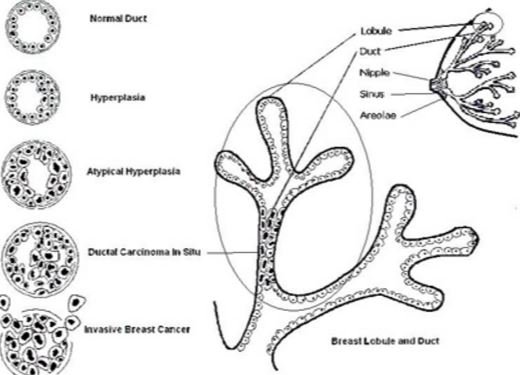Atypical Ductal Hyperplasia
What is Atypical Ductal Hyperplasia?
Atypical ductal hyperplasia is a medical condition that affects the cells of the breast. This is a precancerous condition that indicates an increased risk of a woman to develop breast cancer [1, 2].
The breast tissues are made up of ducts and lobules. The lobules make the breast milk and the ducts bring it to the nipple. There are normally 2 lines of cells that make up these parts. If there is hyperplasia there will be an atypical pattern of cells in these tissues.
There may be more than 2 layers of cells that develop. If the cell arrangement resemble the normal cell pattern, they may be referred to as usual. Atypical hyperplasia are abnormal cell patterns that do not look like the normal pattern. The 2 known types of hyperplasia are lobular hyperplasia and ductal hyperplasia [1, 2, 3, 4].

ICD-10 Code
The diagnosis code used for atypical ductal hyperplasia of the breast is N60.89. This is for any benign dysplasia of the breast [5].
Causes
The exact cause of atypical ductal hyperplasia is still unknown. This condition is thought to be involved in the transition of cells that will eventually become cancer. The overproduction of normal cells will begin to take on an abnormal form. If this is not managed, it will continue to develop and become a breast cancer. It may continue to grow and affect nearby tissues unless it receives appropriate treatment [1, 4].
Signs and Symptoms
The growth that is caused by atypical duct hyperplasia may not be felt by the patient. These changes are usually detected through a woman’s regular mammogram session [1, 4].
Diagnosis
Health history and physical examination
An atypical ductal hyperplasia may be discovered during a mammogram or a breast examination done in the clinic. A medical history will be elicited by the physician if a suspicious area is detected. Any past medical conditions or family history of breast cancer will be known by the physician [1, 3, 6].
Core breast biopsy
A small tissue sample will be collected from the suspicious breast mass. This may be done through the use of a fine needle. This sample will be submitted to a pathologist for analysis. The pathologist will be able to identify the cell arrangement of the sample. This will help the physician to establish the diagnosis of atypical ductal hyperplasia [1, 3, 6].
Excision biopsy
Once a diagnosis of hyperplasia is identified, the physician may request to perform an excision biopsy. In this procedure, the entire breast mass or a bigger portion of the mass will be removed. This will also be submitted to a pathologist for a microscopic analysis. The bigger specimen may be able to signs of invasive cancer [1, 3, 6].
Treatment
The treatment for atypical ductal hyperplasia depends on the result of the diagnostic test. Once the pathologist have ruled out any abnormalities, there will be no need for further treatment. If atypical ductal hyperplasia is identified, the patient will be closely monitored by the physician. The patient may undergo screening for the breast cancer. This may include self-breast examinations, screening mammograms and breast MRI [3, 4, 6].
Reducing Breast Cancer Risk
Women with atypical ductal hyperplasia have increased risk for developing breast cancer. However, there are several ways to lower this risk. The hormone estrogen is thought to increase breast cancer risk. Therefore, taking selective estrogen medications such as tamoxifen may lower the risk. Those that are going through menopause may undergo hormone therapy to manage the symptoms.
This therapy is associated with breast cancer risk in postmenopausal women. Avoiding this therapy may reduce the risk [3, 4, 6].
For women who have a familial history of breast cancer, undergoing a risk-reducing mastectomy may be beneficial. This atypical ductal hyperplasia treatment option must be discussed by the physician to the patient [3, 4, 6].
Bibliography
- Sneige, N., Lim, S., & al, e. (2003). Atypical Ductal Hyperplasia Diagnosis by Directional Vacuum-Assisted Stereotactic Biopsy of Breast Microcalcifications. American Journal of Clinical Pathology, 119-121.
- American Cancer Society. (2014, October 14). Understanding Your Pathology Report: Atypical Hyperplasia. Retrieved from American Cancer Society: http://www.cancer.org/treatment/understandingyourdiagnosis/understandingyourpathologyreport/breastpathology/atypical-hyperplasia
- Johns Hopkins Medicine. (2016). Atypical Ductal Hyperplasia (ADH). Retrieved from Johns Hopkins Medicine: http://www.hopkinsmedicine.org/breast_center/breast_cancers_other_conditions/atypical_ductal_hyperplasia.html
- Mayo Clinic Staff. (2015, January 8). Atypical hyperplasia of the breast. Retrieved from Mayo Clinic: http://www.mayoclinic.org/diseases-conditions/atypical-hyperplasia/basics/treatment/con-20032601
- ICD10 Data. (2015). Other benign mammary dysplasias of unspecified breast. Retrieved from ICD10 Data: http://www.icd10data.com/ICD10CM/Codes/N00-N99/N60-N65/N60-/N60.89
- Halla, S. (2016, June 21). A brief overview of atypical hyperplasia. Retrieved from Moose & Doc Breast Cancer: http://breast-cancer.ca/atyp-hyp/
